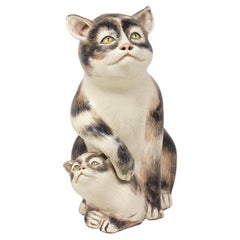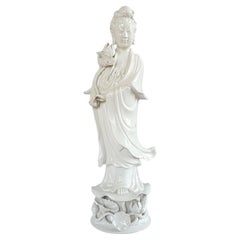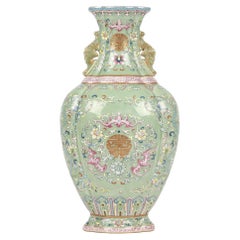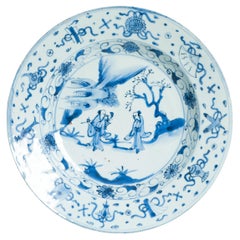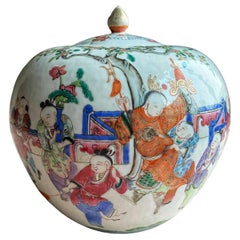Europe - Ceramics
to
498
1,364
1,915
1,278
73
13
37
37
7
4
4
3
3
2
1
1
1
1
1
486
410
382
86
113
77
38
12
11
4
4
23
11
6
7
1
1,277
890
108
73
54
1,170
1,125
740
384
122
1,364
1,325
1,335
37
7
7
7
6
Item Ships From: Europe
Antique Japanese Meiji Period Pottery Cat and Kitten Okimono
Located in Newark, England
EARLY MEIJI PERIOD (1868-1912)
From our Japanese Pottery collection, we are delighted to offer this charming Japanese Pottery Cats Okimono. The Pottery Cats Okimono consisting of a...
Category
Late 19th Century Japanese Meiji Antique Europe - Ceramics
Materials
Ceramic, Earthenware, Pottery
Antique Japanese Meiji Period Satsuma Vase by Okamoto Ryozan for Yasuda Company
Located in Newark, England
MUSEUM QUALITY SATSUMA VASE BY OKAMOTO RYOZAN
From our Japanese Satsuma collection, we are absolutely delighted to bring to market this exceptional Japanese Satsuma Vase by Okamoto...
Category
Early 1900s Japanese Meiji Antique Europe - Ceramics
Materials
Ceramic
Porcelain Blanc de Chine Guanyin statue, China circa 1900 - 51cm
Located in GRENOBLE, FR
A porcelain Blanc de Chine Guanyin statue standing on a fine lotus flowers and leaves decoration ; China circa 1900. This is a tall piece to place on a large mantel or a commode, the...
Category
Early 20th Century Chinese Chinese Export Europe - Ceramics
Materials
Porcelain
Chinese Qianlong Mark Chinese Famille Rose Vase with Bats
Located in Bishop's Stortford, Hertfordshire
A stunning antique Chinese Qing porcelain famille rose vase decorated with bats with Qianlong mark and possibly of the period. The impressive vase of lobed form is painted with shou ...
Category
Late 18th Century Chinese Qing Antique Europe - Ceramics
Materials
Porcelain
Antique Wanli / Tianqi Ming Chinese Porcelain Kraak Chinese Taste Figural Plate
Located in Amsterdam, Noord Holland
Sharing with you this new arrival and very happy with it. Late Ming period Kraak plate of exceptional quality in cobalt blue of larger size. In general the piece is already of high q...
Category
17th Century Chinese Ming Antique Europe - Ceramics
Materials
Porcelain
Large Qing Dynasty Famille Rose Porcelain Ginger Jar
Located in Grythyttan, SE
Antique ginger jar with lid, porcelain, China, Qing Dynasty, 19th century, pumpkin-shaped featuring boys at play in Famille Rose colors.
This elegant piece, an antique ginger jar...
Category
Late 19th Century Chinese Qing Antique Europe - Ceramics
Materials
Enamel
Cobalt Blue & White Prunus Blossom & Cracked Ice Chinese Porcelain Vase
Located in Bad Säckingen, DE
This elegant Chinese porcelain vase features a deep cobalt blue background contrasted beautifully with a delicate white prunus blossom and cracked ice pattern.
The slender neck and...
Category
Mid-20th Century Chinese Mid-Century Modern Europe - Ceramics
Materials
Porcelain
Chinese Export Porcelain Plate Rose Medallion Hand Painted, Qing, circa 1875
Located in Lincoln, Lincolnshire
This is a very decorative Chinese Export, porcelain, Rose Medallion dish or plate which we date to the 19th century, Qing dynasty, circa 1875.
I...
Category
19th Century Chinese Chinese Export Antique Europe - Ceramics
Materials
Porcelain
Chinese Ming Dynasty Ko-Sometsuke Wucai Porcelain Plate
Located in Newark, England
CHONGZHENG 1628-1644
From our Chinese collection, we are delighted to offer this rare example Chinese Ko-Sometsuke Wucai Porcelain Plate. The plate potted in porcelain ceramic of ci...
Category
Early 17th Century Chinese Ming Antique Europe - Ceramics
Materials
Ceramic, Porcelain
Late 19th Century Qing Dynasty Matching Pair Chinese Famille Rose Vases
Located in Silvolde, Gelderland
Beautiful set of two matching Qing Dynasty porcelain vases. These vase are both in good condition and add absolute great value to your interior.
Category
Late 19th Century Chinese Chinese Export Antique Europe - Ceramics
Materials
Porcelain
Chinese Qianlong Style Mille Fleur Pastel Toned Gold Decorative Charger Plate
Located in Glasgow, GB
A decorative 1980s gold and pastel toned Chinese porcelain charger plate, handcrafted and adorned in the Mille Fleur style; a design known as the "thousand flowers" pattern.
The M...
Category
1980s Chinese Qing Vintage Europe - Ceramics
Materials
Enamel, Gold
Antique Chinese Porcelain Famille Verte Soap Box Qing Dynasty 19th Century
Located in Bad Säckingen, DE
This charming rectangular porcelain soap box with lid is a fine example of Chinese Famille Verte ware from the Qing Dynasty, dating to the 19th century. The hand-painted decoration f...
Category
1890s Chinese Chinese Export Antique Europe - Ceramics
Materials
Enamel
Antique Chinese Export Vase Canton Rose Medallion Porcelain, Qing circa 1840
Located in Lincoln, Lincolnshire
This is a very decorative Chinese export, Canton porcelain, rose medallion Vase which we date to the 19th century, Qing dynasty, circa 1840.
The vase has a baluster shape with a f...
Category
19th Century Chinese Chinese Export Antique Europe - Ceramics
Materials
Porcelain
Japanese Porcelain Charger or Large Plate Hand Painted Imari, 19th C Meiji
Located in Lincoln, Lincolnshire
This is a good quality Japanese porcelain large plate or dish or charger with an Imari pattern, dating to the mid-late 19th century, Meiji period, circa 1870.
The plate or charger...
Category
19th Century Japanese Meiji Antique Europe - Ceramics
Materials
Porcelain
Chinese Export Vase porcelain Blue & White hand painted dragons, Circa 1950
Located in Lincoln, Lincolnshire
This is an elegant porcelain Chinese export porcelain Bottle Vase raised on a low foot, all hand painted in a blue and white dragon pattern, which we date to the mid 20th century, circa 1950.
The vase is fairly large and very well hand potted in a Classic bottle shape on a low foot having a clear white glaze with a light blue tinge. The base is also glazed to the centre and the foot rim has been carefully hand-cut.
The vase is finely hand painted in a large range of cobalt blue tones from a light blue to a deep dark, almost black tones of cobalt blue, all around the body with two five toed dragons dancing among clouds. There are border patterns around the foot rim and the lower body all between blue circles with double blue circles just below the top rim.
The base has a carefully hand painted underglaze-blue six-character apocryphal Qing - Qianlong ( 1736 to 1795) seal mark, though we date this vase to the mid 20th century.
Approximate Weight: about 2.3Kg. unpacked.
Overall a beautiful Chinese blue and white hand painted Vase
Category
Mid-20th Century Chinese Chinese Export Europe - Ceramics
Materials
Porcelain
Antike Awaji Pottery braided with bamboo, Japan around 1900s
Located in Hannover, DE
This beautiful vase is hand made and its made in japan. all the materials used to make this vase are natural. one can use this vase to decorate the room in different ways. One can ch...
Category
Early 1900s Japanese Antique Europe - Ceramics
Materials
Ceramic
Wonderful quality antique Japanese imari plate
Located in Ipswich, GB
Wonderful quality antique Japanese imari plate with a wavy shaped edge, decorated highly with flowers and leaves hand painted in stunning red, white, blue and gold colours.
D. 1900
Category
20th Century Japanese Europe - Ceramics
Materials
Ceramic
Mid 19thC Large 42cm Chinese Export Vase Porcelain Rose Medallion, Qing Ca 1850
Located in Lincoln, Lincolnshire
This is a very good quality, highly decorative Chinese export Large porcelain Vase, finely hand decorated in the Imperial Canton, Rose medallion figural design, which we date to the mid 19th century, Qing dynasty, circa 1850.
This is a large vase over 16 inches high. ( ~42cm)
The vase has a baluster shape with a flared rim and is embellished with gold gilded dragons or salamanders at the shoulder with gold Foo Dog side handles. This is a well potted heavy vase indicative of the earlier Canton pieces, weighing about 3.5 Kg unpacked.
It is hand-painted in the Canton or Chinese export, rose medallion decoration with two sets of four panels...
Category
19th Century Chinese Chinese Export Antique Europe - Ceramics
Materials
Porcelain
Geode and kintsugi Bizen vase
Located in MEAUX, FR
Restored Bizen stoneware vase with kintsugi and geode
This 13 cm high Bizen stoneware vase is a unique and exceptional piece. Doubly incredible, it was broken and then restored ...
Category
21st Century and Contemporary Japanese Europe - Ceramics
Materials
Gold
Antique Ming Wanli 1560-1590 Chinese Porcelain Swatow/Zhangzhou Bowl
Located in Amsterdam, Noord Holland
A Chinese blue and white porcelain bowl with cranes and flowers.
end of the 16th century. Swatow
——————————————————————————————————————
Condition
2 chips to rim and crackle lines. ...
Category
17th Century Chinese Ming Antique Europe - Ceramics
Materials
Porcelain
Japanese Porcelain Green Umbrella Stand 1970s
Located in Paris, FR
This is an umbrella stands which was made in Japan around 1970 in showa era.
It is made with porcelain. The colour of this umbrella stand is light green and it has some leaves motif....
Category
Late 20th Century Japanese Showa Europe - Ceramics
Materials
Porcelain
Japanese Porcelain Charger finely Hand Painted, Meiji Period circa 1880
Located in Lincoln, Lincolnshire
This is a good quality, hand decorated Japanese porcelain charger, large plate or bowl with an Imari pattern, dating to the late 19th centur...
Category
Late 19th Century Japanese Meiji Antique Europe - Ceramics
Materials
Porcelain
Chinese Pair Turquoise Glazed Porcelain Standing Foo Dogs
Located in Bishop's Stortford, Hertfordshire
A fine and attractive pair of Chinese turquoise glazed dogs of foo figures dating from the first half of the 20th century. The stylish pair hollow biscuit porcelain figures are model...
Category
Early 20th Century Chinese Chinese Export Europe - Ceramics
Materials
Porcelain
Chinese Export Porcelain Plate Famille Rose Hand Painted Figures, Circa 1940s
Located in Lincoln, Lincolnshire
This is a good Chinese Export porcelain Plate which has been beautifully hand enamelled, over-glaze, in the Famille Rose palette with excellent detail, dating to Circa 1940.
The mai...
Category
Mid-20th Century Chinese Chinese Export Europe - Ceramics
Materials
Porcelain
PAIR of Chinese Foo Dogs Hand Carved Hardstone Good Colour and Detail, Ca 1940
Located in Lincoln, Lincolnshire
These are a very good pair of antique Chinese foo or lion dogs, sometimes called temple lions made of a hardstone, hand carved with fine detail and polished, dating to the mid 20th c...
Category
Mid-20th Century Chinese Qing Europe - Ceramics
Materials
Stone
Chinese Qianlong Hand Painted Porcelain Plate, 18th Century
Located in Bishop's Stortford, Hertfordshire
An exceptional antique Chinese Qianlong porcelain plate decorated in underglaze blue and overpainted in red and green glazes with light gilding with...
Category
18th Century Chinese Antique Europe - Ceramics
Materials
Porcelain
Two PAIRs of Chinese Export Cups and Saucers egg-shell porcelain, Qing 19th C
Located in Lincoln, Lincolnshire
This is Two PAIRS of Chinese export Cups and Saucers made from eggshell porcelain and hand painted in the very decorative Rose Medallion ...
Category
19th Century Chinese Chinese Export Antique Europe - Ceramics
Materials
Porcelain
18thC Chinese Porcelain Bowl Hand Painted Famille Rose, Qing Qianlong circa 1760
Located in Lincoln, Lincolnshire
This is a finely hand painted Chinese porcelain bowl from the 18th century, Qing dynasty, Qianlong period, 1736-1795.
The bowl is beautifully decorated with two panels of figure sce...
Category
Mid-18th Century Chinese Chinese Export Antique Europe - Ceramics
Materials
Porcelain
Japanese Flower Pot Porcelaine ChojuGiga design 1990s Showa
Located in Paris, FR
This flower pot was made in Japan around 1990s. It is made with porcelaine.
The motif of this pot is called 'Choju Giga' which is oldest manga in Japan.
Chōjū-jinbutsu-giga, commonl...
Category
1990s Japanese Europe - Ceramics
Materials
Porcelain
Japanese Earthenware Meiji Period Satsuma Iris Vase by Ryuzan
Located in Newark, England
Meiji Period (1868-1912)
From our Japanese collection, we are delighted to offer this Japanese Satsuma Iris Vase Painted by Ryuzan. The Japanese Satsuma vase of tall tapered form features a circular rolled foot rim, slightly pinched base with a tapered body and slightly bulbous opening. The vase is decorated with a central continuous band of bright iris flowers with various shades of green to the stems and beautiful violet petals. The central band is framed by greek key borders and honeycomb geometric patterns to the top and bottom. The vase is signed to the base Ryuzan 龍山 and dates to the Meiji Period (1868-1912) and the late 19th century circa 1895.
Satsuma ware is a type of earthenware pottery originating from the Satsuma province in Southern Kyushu, Japan’s third largest island.
Meiji Period was an era of Japanese history that spanned from 1868 to 1912. It was the first half of the Empire of Japan, when the Japanese people began to build a paradigm of a modern, industrialised nation state and emergent great power, influenced by Western countries and aesthetics. As a result of radically different ideas, the changes to Japan were profound and it affected the social structure, politics, economy, military, and foreign relations across the board. The period corresponded to the reign of Emperor Meiji and was preceded by the Keio era and was succeeded by the Taisho era.
Cultural Art during the Meiji Period was of particular interest to the government and they overhauled the art export market which in turn promoted Japanese arts via various world’s fairs, beginning in Vienna at the world fair in 1873. The government heavily funded the fairs and took an active role organising how Japan’s culture was presented to the world including creating a semi-public company named Kiritsu Kosho Kaisha (First Industrial Manufacturing Company). The Kiritsu Kosho Kaisha was used to promote and commercialise exports of Japanese art and established the Hakurankai Jimukyoku (Exhibition Bureau) to maintain quality standards. For the 1876 Centennial International Exhibition in Philadelphia, the Japanese government created a Centennial Office and sent a special envoy to secure space for the 30,000 items that would be displayed. The Imperial Household also took an active interest in arts and crafts, commissioning works by select artists to be given as gifts for foreign dignitaries further emphasising the high quality and importance of Japanese art. Just before the end of the 19th century in 1890, the Teishitsu Gigeiin (Artist to the Imperial Household) system was created to recognise distinguished artists. These artists were selected for their exceptionally high quality wares and talent in their own industry. Over a period of 54 years Seventy artists were appointed, amongst these were ceramicist Makuzu Kozan and cloisonné enamel artist...
Category
Late 19th Century Japanese Meiji Antique Europe - Ceramics
Materials
Earthenware
Unusual Antique Qing Chinese Porcelain Laughing Buddha Sancai Glazed c1920
Located in Bad Säckingen, DE
The unusual antique ca. 1920 Qing Chinese porcelain Laughing Buddha is a remarkable and exquisite piece of art that exudes charm and cultural...
Category
1920s Chinese Qing Vintage Europe - Ceramics
Materials
Porcelain
18th Century Chinese porcelain Famille Rose Teapot with Cover
Located in Delft, NL
18th Century Chinese porcelain Famille Rose Teapot with Cover
An early Qianlong enameled porcelain teapot with a scene of birds and Peonies in a g...
Category
18th Century Chinese Antique Europe - Ceramics
Materials
Porcelain
Japanese Meiji Period (1868-1912) Satsuma Earthenware Vase Taizan for Hattori
Located in Newark, England
Meiji Period (1868-1912)
From our Japanese collection, we are delighted to offer Japanese Meiji Period Satsuma Vases. The Satsuma Vase of hexagonal form with a slight waisted neck and tight rounded rim is extensively decorated with multiple figures to two large scenes. The first scene features a beach with waves to the background and a plethora of figures including multiple geisha holding traditional Japanese wagasa’s. The second scene follows on from the first with a large building in the foreground holding figures on a large platform under a pagoda roof with a pagoda building in the background and further figures in the foreground. The scenes are framed by a full detailed border with gilt shapes, flowers amongst pink shaded backgrounds and butterflies around the neck. The Satsuma Vase is unusually signed Fine Art, Satsuma Ware, Dai Nippon (Great Japan), Hattori Made, Gosuido Works, Taizan Painted. 美術, サツマヤキ(薩摩焼), 大日本, 服部造, 五スイ堂工, 對山画 and dates to the Meiji Period (1868-1912) and the turn of the 20th century circa 1905.
Satsuma ware is a type of earthenware pottery originating from the Satsuma province in Southern Kyushu, Japan’s third largest island.
Wagasa are traditional Japanese umbrellas made of washi paper attached to a bamboo frame and treated to ensure it is waterproof.
Meiji Period was an era of Japanese history that spanned from 1868 to 1912. It was the first half of the Empire of Japan, when the Japanese people began to build a paradigm of a modern, industrialised nation state and emergent great power, influenced by Western countries and aesthetics. As a result of radically different ideas, the changes to Japan were profound and it affected the social structure, politics, economy, military, and foreign relations across the board. The period corresponded to the reign of Emperor Meiji and was preceded by the Keio era and was succeeded by the Taisho era.
Cultural Art during the Meiji Period was of particular interest to the government and they overhauled the art export market which in turn promoted Japanese arts via various world’s fairs, beginning in Vienna at the world fair in 1873. The government heavily funded the fairs and took an active role organising how Japan’s culture was presented to the world including creating a semi-public company named Kiritsu Kosho Kaisha (First Industrial Manufacturing Company). The Kiritsu Kosho Kaisha was used to promote and commercialise exports of Japanese art and established the Hakurankai Jimukyoku (Exhibition Bureau) to maintain quality standards. For the 1876 Centennial International Exhibition in Philadelphia, the Japanese government created a Centennial Office and sent a special envoy to secure space for the 30,000 items that would be displayed. The Imperial Household also took an active interest in arts and crafts, commissioning works by select artists to be given as gifts for foreign dignitaries further emphasising the high quality and importance of Japanese art. Just before the end of the 19th century in 1890, the Teishitsu Gigeiin (Artist to the Imperial Household) system was created to recognise distinguished artists. These artists were selected for their exceptionally high quality wares and talent in their own industry. Over a period of 54 years Seventy artists were appointed, amongst these were ceramicist Makuzu Kozan and cloisonné enamel artist...
Category
Early 1900s Japanese Meiji Antique Europe - Ceramics
Materials
Earthenware, Pottery
Chinese Porcelain large Plate or Dish Celadon Famille Rose hand painted, Ca 1820
Located in Lincoln, Lincolnshire
This is a very good Chinese Export, (Canton) large porcelain plate or dish, all hand painted with a light green celadon glaze, which we date to the early 19th century, circa 1820, of the Qing dynasty.
A feature of this plate is its size, having a large dinner plate diameter of nearly 10 inches, as the majority of plates of this type have a much smaller diameter .
The plate has a light green, Celadon ground glaze with beautifully hand painted decoration, in over-glaze poly-chrome enamels of the Famille-Rose palette, featuring a bird, butterflies, fruits and flowers.
The rim is hand painted in a café-au-lait light brown finish.
There is an under-glaze, cobalt blue square seal mark, hand painted to the base.
Overall a very good large example of a beautiful Chinese hand painted plate...
Category
Early 19th Century Chinese Chinese Export Antique Europe - Ceramics
Materials
Porcelain
18thC Chinese Export Porcelain Bowl Hand Painted Famille Rose, Qing Ca 1780
Located in Lincoln, Lincolnshire
This is a hand painted Chinese export bowl from the late 18th century, Qing dynasty, Qianlong period, 1736-1795. We date this piece to...
Category
18th Century Chinese Chinese Export Antique Europe - Ceramics
Materials
Porcelain
Pair of Japanese Satsuma 'Moriage' Porcelain Gilt Vases
By Satsuma
Located in LA CIOTAT, FR
This handsome pair of 20th century glazed and gilded Japanese Satsuma vases, with their vivid, jewel-like colours and elegant baluster-shaped forms, feature the traditional Japanese ...
Category
20th Century Japanese Europe - Ceramics
Materials
Porcelain
Chinese Imari Porcelain Plate or Bowl Qing Kangxi Mark and period, Ca 1700
Located in Lincoln, Lincolnshire
This is a beautifully hand painted Chinese Export porcelain plate or bowl from the Qing, Kangxi period, 1662-1722, fully marked to the base with the Kangxi period Artemisia Leaf mark within a double blue ring.
The plate is of dinner plate size, finely potted with a carefully cut base rim and a lovely rich glassy, white glaze with a light blue tinge.
The plate is carefully hand painted in a free flowing style, characteristic of the period, in varying shades of a clear cobalt blue, iron red and gold. The central well is decorated in the Imari style with flowering peonies, asters and other flowers and grasses, with a small insect flying above the flowers, all within two sets of concentric blue circles. The outer rim is richly decorated with flower sprigs and leaves, all within an outer blue circle.
The base of the plate has a recognized and documented hand painted Kangxi symbol of an Artemisia Leaf, within a double blue ring. See Page 168 of "How to Identify Old Chinese Porcelain" by Willoughby Hodgson and published by Forgotten Books. A Kangxi plate...
Category
Early 18th Century Chinese Chinese Export Antique Europe - Ceramics
Materials
Porcelain
Kangxi Period Chinese Plate Porcelain Blue & White Chenghua Mark, Circa 1680
Located in Lincoln, Lincolnshire
This is a very beautifully hand painted Chinese porcelain blue and white Dish or Plate from the Qing, Kangxi period ( 1662-1722), dating to Circa 1680 or slightly earlier
This is a well potted dish with 16 lobes or ribs, a wavy barbed rim, a very well cut foot rim and a very white glaze.
The plate is very finely hand painted in a free flowing style, characteristic of the period, in varying shades of a clear cobalt blue, from the very dark to the very light blue.
The central well is hand decorated with an iconic outdoor...
Category
Late 17th Century Chinese Qing Antique Europe - Ceramics
Materials
Porcelain
Antique Japanese Imari Porcelain Umbrella Stand
By Imari Porcelain
Located in LA CIOTAT, FR
An ideal decoration for a stylish hallway, this Japanese Imari porcelain umbrella stand dates from the end of the 19th century. Known for its colourful decorative style, Imari porcelain features vivid hand-painted designs in bright shades of cobalt blue, red, gold and black and this unfussy but elegant cylindrical vase is a prime example. Also typical of the style is its busy motif of wise elders deep in conversation in a landscape, surrounded by radiant cherry blossoms and peonies, bamboo stems and pendulous willow boughs...
Category
19th Century Japanese Antique Europe - Ceramics
Materials
Porcelain
Japanese Little Porcelain Box for Incense and Jewelry 1980s KOUUN
Located in Paris, FR
This is a small box which is made with porcelain.
This can be used as KOURO (the box we use to put some incense which we use during a traditional tea ceremony.). And also as a jewelr...
Category
Late 20th Century Japanese Showa Europe - Ceramics
Materials
Porcelain
Chinese Yixing Red Clay Teapot Poems & Bamboo Leaves Seal Mark, C 1950
Located in Lincoln, Lincolnshire
This is a Chinese handcrafted Red Clay Yixing teapot and cover, which we date to the 20th century, circa 1950.
The Teapot and lid are handcrafted in an ...
Category
Mid-20th Century Chinese Qing Europe - Ceramics
Materials
Clay, Stoneware
Large SanCai Glazed Pottery Horse Statue Chinese Tang Dynasty Style
Located in Bochum, NRW
Chinese Tang Sancai-glazed pottery statue of a horse standing on all four legs atop a rectangular base. The horse is decorated with bells and flowers. A traditional green saddle comp...
Category
Mid-20th Century Chinese Tang Europe - Ceramics
Materials
Terracotta
Japanese Arita Blue and White Kraak Dish - Edo Period, late 17th
By 1616 / Arita Japan
Located in DELFT, NL
A 17th Century Japanese Blue and White Porcelain Dish in the Kraak Style, Arita Kilns 1670 – 1700.
The central design shows three pheasant, one perched on a rock amongst flowering p...
Category
Late 17th Century Japanese Edo Antique Europe - Ceramics
Materials
Porcelain
Chinese Imari Porcelain Plate or Bowl Qing Kangxi Mark & period, Ca 1700
Located in Lincoln, Lincolnshire
This is a beautifully hand painted Chinese Export porcelain Plate or Bowl from the Qing, Kangxi period, 1662-1722, fully marked to the base with the Kang...
Category
Early 18th Century Chinese Chinese Export Antique Europe - Ceramics
Materials
Porcelain
Antique Pair of Large Chinese Vases
Located in LA CIOTAT, FR
A superb pair of large and elegant Chinese 'Nanjing' porcelain baluster vases, each intricately decorated with an encircling battle scene of warriors on foot and on horseback on its ...
Category
Early 20th Century Chinese Europe - Ceramics
Materials
Porcelain, Paint
Antique 19thC Japanese Meiji Imari Blue & White Chintz Porcelain Plate Charger
Located in Bad Säckingen, DE
This antique Japanese Imari porcelain plate charger dates to the Meiji period, circa 1880. It showcases a stunning blue and white chintz pattern with detailed floral and scrollwork m...
Category
1880s Japanese Meiji Antique Europe - Ceramics
Materials
Porcelain
Famille Verte Qing Dinasty Chinese Art Antique Porcelain Vase
Located in Brescia, IT
Porcelain Vase
Famille Vetre
Qing Dinasty
1920
Excellent Condiction
Category
1920s Chinese Chinoiserie Vintage Europe - Ceramics
Materials
Porcelain
Persian Hand Painted Large Earthenware Tile with Recumbent Deer
Located in Bishop's Stortford, Hertfordshire
From a small collection of Persian hand painted pottery is this stylish large earthenware tile hand painted with a recumbent deer with flowering stems and dating from the early to mi...
Category
Early 20th Century Qatari Islamic Europe - Ceramics
Materials
Earthenware, Pottery
Antique Edo/Meiji Period 18/19C Japanese Hirado Cachepot with Boys playing
Located in Amsterdam, Noord Holland
This is a most unusually made antique Hirado porcelain cachepot with playing boys. Crisply modelled with cobalt blue glaze
About Hirado 平戸 Ware
The origins of Hirado ware (it's als...
Category
19th Century Edo Antique Europe - Ceramics
Materials
Porcelain
Antique Ming Wanli 1600-1640 Chinese Porcelain Kosometsuke Plate Cows
Located in Amsterdam, Noord Holland
A Chinese blue and white porcelain Dish of beautiful shape and design.
Visible is a scene of a sheperd with cows. A poem is also visible at the top.
Early 17th century.
Similar dishe...
Category
17th Century Chinese Ming Antique Europe - Ceramics
Materials
Porcelain
Fine quality antique Japanese imari bowl
Located in Ipswich, GB
Fine quality antique Japanese imari bowl having a lovely antique Japanese imari bowl with wonderful hand painted panels with leaves, trees and flowers in wonderful red, blue, green, ...
Category
Early 20th Century Europe - Ceramics
Materials
Ceramic
Chinese Export Porcelain Bowl Hand Painted Blue and White, 18thC or earlier
Located in Lincoln, Lincolnshire
This is a Chinese Export porcelain bowl, hand painted in a blue and white pattern, which we date to the 18th Century or earlier, back to late Ming dynasty in the early 17th century. ...
Category
Mid-18th Century Chinese Chinese Export Antique Europe - Ceramics
Materials
Porcelain
Chinese Nanjing Crackleware Blue and White Vase
Located in LA CIOTAT, FR
Full of character, this wonderful late 19th century Chinese Nanjing baluster vase features exquisite hand-painted decorations of birds and fish in vivid blue around its lower belly a...
Category
19th Century Chinese Antique Europe - Ceramics
Materials
Porcelain
Chinese Porcelain Snuff Bottle Blue & White Hand Painted, Circa 1940
Located in Lincoln, Lincolnshire
This is a good Chinese Export snuff bottle, made from porcelain and hand painted in cobalt blue, dating to the mid 20th century, circa 1940.
This piece is well potted with a balus...
Category
Mid-20th Century Chinese Chinese Export Europe - Ceramics
Materials
Porcelain
"Blanc de Chine" Guanyin with Lotus Flower Porcelain, circa 1900
Located in Beuzevillette, FR
Porcelain "Blanc de Chine" Statuette of a Guanyin stand on a lotus leaf, holding a lotus flower.
China.
Early 20th century.
Category
Early 20th Century Chinese Chinoiserie Europe - Ceramics
18th C Chinese Porcelain Plate Blue & White Hand Painted, Qing Qianlong Ca 1770
Located in Lincoln, Lincolnshire
This is a hand painted blue and white Chinese porcelain plate, dating to the second half of the 18th century, circa 1770, the Qing Qianlong dynasty.
This very good condition of this...
Category
18th Century Chinese Chinese Export Antique Europe - Ceramics
Materials
Porcelain
Japanese Meiji Period (1868-1912) Satsuma Vase by Kinkozan
By Kinkozan
Located in Newark, England
JAPANESE SATSUMA PROCESSIONAL VASE
From our Japanese collection, we are delighted to introduce to the market this Japanese Satsuma Vase by Kinkozan. The vase with a compressed body ...
Category
Late 19th Century Japanese Meiji Antique Europe - Ceramics
Materials
Ceramic, Earthenware, Pottery
Japanese Modern LAAB Nauru Sculpture Raku Ceramic Green White Black Metal
By LAAB Milano
Located in monza, Monza and Brianza
Nauru sculpture
The copper details of this sculpture are able to show different colors thanks to the concentric lines present on the surface that expand and contract the space whe...
Category
21st Century and Contemporary Italian Modern Europe - Ceramics
Materials
Ceramic
